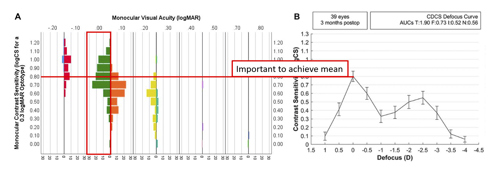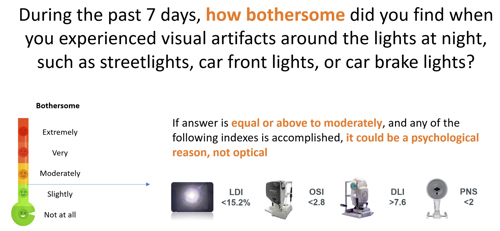Cataract, Refractive, Presbyopia, IOL
Overcoming Obstacles to Presbyopia-Correcting IOLs
New technology can smooth the path to premium IOL acceptance.

Dermot McGrath
Published: Monday, June 3, 2024
“ Surgeons with more than 10 years of experience and in private practice present slightly higher ratios of concern. “
Many of the principal barriers to the adoption of presbyopia-correcting intraocular lenses can be overcome with a combination of rigorous preoperative screening procedures, personalised IOL selection, and patient counselling, according to Joaquin Fernández MD, PhD.
“The most recent ESCRS Clinical Trends Survey showed the cost to the patient and concerns about the night-time quality of vision and loss of contrast sensitivity are the major concerns of surgeons in implanting presbyopia-correcting IOLs,” he said. “We think the postoperative complaints can be prevented or minimised with screening procedures in the preoperative period and appropriate technology selection in the postoperative period. Concerns about the costs can be managed with cost-effectiveness research studies from the patient’s perspective.”
Although results from the ESCRS Clinical Trends surveys show that presbyopia-correcting IOL use has been increasing in recent years, premium IOLs are still implanted in a minority of cases. In 2023, just 11% of respondents were implanting presbyopia-correcting IOLs, the same percentage as the previous year.
“Surgeons with more than 10 years of experience and in private practice present slightly higher ratios of concern,” Dr Fernández noted. “Surgeons in eastern Europe were also slightly more concerned about patient cost than their counterparts in western Europe.”
Looking at the key issues involved, Dr Fernández said the policy in his clinic is never to dismiss or diminish potential concerns about a potential loss of contrast sensitivity.
“It is very important in the preoperative examination to determine the contrast sensitivity of those patients with visual acuity of 20/20 or better,” he said. “We use direct screening measures with a preoperative measurement of the contrast sensitivity defocus curve in the range of +0.50 D to -0.50 D with best distance correction using the Multifocal Lens Analyser application, which can be downloaded on an iPad (https://apple.co/3TSGlDd). It enables us to determine the cut-off point at which the patient will start to experience a negative impact on their contrast sensitivity from an implanted multifocal IOL.” (Figure 1)

Dr Fernández and co-workers validated this approach in a recent study in which they measured distance-corrected contrast sensitivity defocus curve (CSDC) and visual acuity and graded crystalline lens sclerosis with three objective metrics: Ocular Scatter Index (OSI), Dysfunctional Lens Index (DLI), and Pentacam Nucleus Staging (PNS).1 The surgeons can therefore decide to directly measure the contrast sensitivity or estimate it with these indices, whose cut-offs for contrast sensitivity ≤0.8 logCS have been calculated as >1.25, <7.67 and >1.0, for OSI, DLI, and PNS, respectively.
A similar approach may also prove effective in anticipating issues with night-time quality of vision, Dr Fernández said.
His team carried out a study to assess the photic phenomena (PP) and positive dysphotopsia in patients using light distortion index (LDI) and parameters obtained from a simulator, both of which were combined with subjective disturbances related to PP.2 This enabled them to obtain cut-off values for LDI that better predicted patients passing from “slightly” to “moderately” bothersome in terms of photic phenomena. The team also assessed the relationships between LDI and objective cataract grading methods, including OSI, DLI, and PNS.
“Patients reporting moderately or higher bothersome levels in the preoperative period and with LDI less than 15.20%, less than 2.8 for OSI, greater than 7.6 for DLI, and less than 2 for PNS might deserve special attention in the multifocal intraocular lens selection,” he advised. (Figure 2)

Finally, in terms of the additional costs associated with presbyopic IOLs, Dr Fernández said it was important to explain the cost-effectiveness of such procedures from a patient’s perspective, since the patient is usually responsible for these additional costs, drawing on effectiveness published studies in the scientific literature. Dr Fernández’s team has developed a tool named IOLEvidence (https://apple.co/498YGC5), which provides updated information on IOL effectiveness as provided by studies of intraocular lenses organised by the new evidence-based functional classification.3
Dr Fernández presented at the ESCRS Winter Meeting in Frankfurt.
Joaquin Fernández MD, PhD is CEO and Medical Director of the Ophthalmology Department at Qvisión in Vithas Virgen del Mar Hospital, Almería, Spain. JoaquinFernandezoft@Qvision.es
1. Fernández J, Burguera N, Rocha-de-Lossada C, Rachwani-Anil R, Rodríguez-Vallejo M. “Objective cataract grading methods and expected contrast sensitivity reestablishment with multifocal intraocular lenses,” Int Ophthalmol, 2023; 43(8): 2825–2832. DOI: 10.1007/s10792-023-02680-8.
2. Fernández J, Burguera N, Rocha-de-Lossada C, Zamorano-Martín F, Rodríguez-Vallejo M. “Screening of positive dysphotopsia before multifocal intraocular lens implantation,” Indian J Ophthalmol, 2024; 72: S211–S217.
3. Fernández J, Ribeiro F, Rocha-de-Lossada C, Rodríguez-Vallejo M. “Functional Classification of Intraocular Lenses Based on Defocus Curves: A Scoping Review and Cluster Analysis,” J Refract Surg, 2024; 40: e108–e116.
Tags: cataract, refractive, presbyopia, presbyopia-correcting IOLs, IOL selection, IOL, ESCRS Clinical Trends Survey, patient counselling, preoperative, light distortion index, LDI, photic phenomena (PP), preoperative screening, Joaquin Fernandez, Fernandez
Latest Articles
Towards a Unified IOL Classification
The new IOL functional classification needs a strong and unified effort from surgeons, societies, and industry.
Organising for Success
Professional and personal goals drive practice ownership and operational choices.
Update on Astigmatism Analysis
Is Frugal Innovation Possible in Ophthalmology?
Improving access through financially and environmentally sustainable innovation.
iNovation Innovators Den Boosts Eye Care Pioneers
New ideas and industry, colleague, and funding contacts among the benefits.
José Güell: Trends in Cornea Treatment
Endothelial damage, cellular treatments, human tissue, and infections are key concerns on the horizon.
Making IOLs a More Personal Choice
Surgeons may prefer some IOLs for their patients, but what about for themselves?
Need to Know: Higher-Order Aberrations and Polynomials
This first instalment in a tutorial series will discuss more on the measurement and clinical implications of HOAs.
Never Go In Blind
Novel ophthalmic block simulator promises higher rates of confidence and competence in trainees.